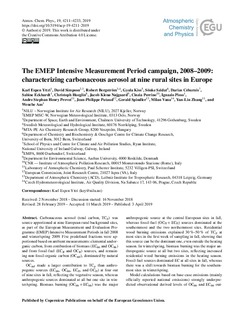| dc.description.abstract | Carbonaceous aerosol (total carbon, TCp) was source apportioned at nine European rural background sites, as part of the European Measurement and Evaluation Programme (EMEP) Intensive Measurement Periods in fall 2008 and winter/spring 2009. Five predefined fractions were apportioned based on ambient measurements: elemental and organic carbon, from combustion of biomass (ECbb and OCbb) and from fossil-fuel (ECff and OCff) sources, and remaining non-fossil organic carbon (OCrnf), dominated by natural sources. OCrnf made a larger contribution to TCp than anthropogenic sources (ECbb, OCbb, ECff, and OCff) at four out of nine sites in fall, reflecting the vegetative season, whereas anthropogenic sources dominated at all but one site in winter/spring. Biomass burning (OCbb + ECbb) was the major anthropogenic source at the central European sites in fall, whereas fossil-fuel (OCff + ECff) sources dominated at the southernmost and the two northernmost sites. Residential wood burning emissions explained 30 %–50 % of TCp at most sites in the first week of sampling in fall, showing that this source can be the dominant one, even outside the heating season. In winter/spring, biomass burning was the major anthropogenic source at all but two sites, reflecting increased residential wood burning emissions in the heating season. Fossil-fuel sources dominated EC at all sites in fall, whereas there was a shift towards biomass burning for the southernmost sites in winter/spring. Model calculations based on base-case emissions (mainly officially reported national emissions) strongly underpredicted observational derived levels of OCbb and ECbb outside Scandinavia. Emissions based on a consistent bottom-up inventory for residential wood burning (and including intermediate volatility compounds, IVOCs) improved model results compared to the base-case emissions, but modeled levels were still substantially underestimated compared to observational derived OCbb and ECbb levels at the southernmost sites. Our study shows that natural sources are a major contributor to carbonaceous aerosol in Europe, even in fall and in winter/spring, and that residential wood burning emissions are equally as large as or larger than that of fossil-fuel sources, depending on season and region. The poorly constrained residential wood burning emissions for large parts of Europe show the obvious need to improve emission inventories, with harmonization of emission factors between countries likely being the most important step to improve model calculations for biomass burning emissions, and European PM2.5 concentrations in general. | nb_NO |

